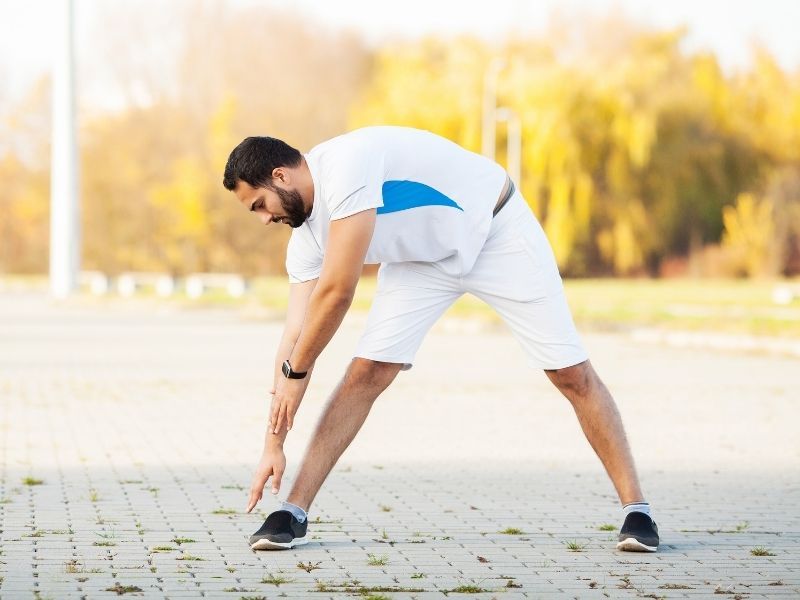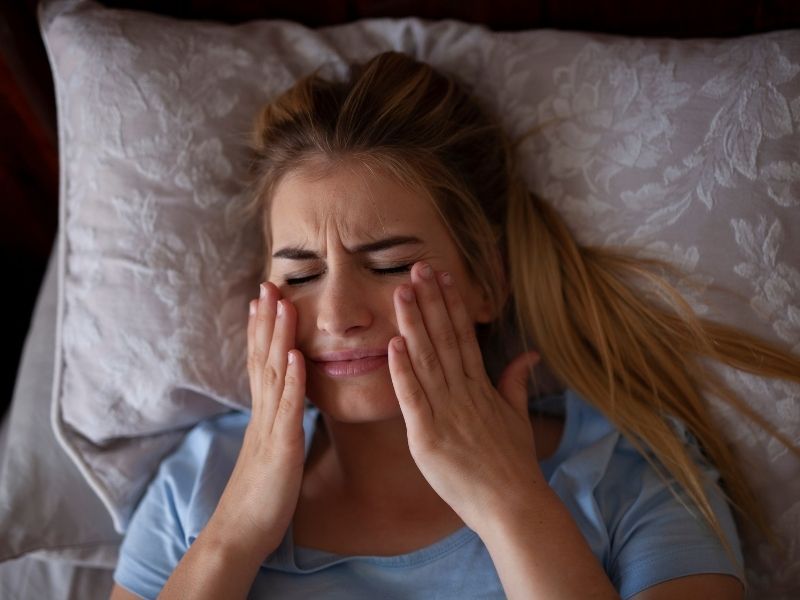Lower Back Pain When Stretching? – How To Fix It

We have all experienced the occasional achy back. In fact, most people will experience back pain at some time in their lives. At first the discomfort is short lived and tends to go away on its own.
But over time, these episodes can become more frequent, lasting longer and longer. Friends, fitness specialists and health care professionals may recommend stretching to alleviate your back pain.
After a little research, you add a nice stretch routine. Unfortunately, you find that your lower back is worse after stretching. Well, you are not alone. If your back feels so tight, why does stretching make the back pain worse?
What is pain? (A useful re-frame!)
The experience of pain is our brain’s way of notifying us of an unpleasant and potentially damaging stimulus. Pain is our body’s way of reacting and protecting itself from tissue damage.
There are receptors in our muscles, joints, skin, bones, and tendons, called nociceptors. Nociceptors are sensory receptors that respond to mechanical force, chemical irritation and temperature.
Nociceptors will be stimulated by potentially harmful joint forces, tissue stretching or pinching, and chemical irritation such as inflammation.
When you experience back pain during stretching or soreness after stretching, the nociceptors were sufficiently stimulated to notify the brain about the potential of injury or damage to the body.
So what exactly is stimulating nociceptors in the low back pain with stretching?
First it is important to point out that pain is highly subjective and every body is different.
This is especially true for proper selection of exercises, including stretches. There are many potential causes of pain during stretching – inflammation from injured tissues, tight tissues being stretched further, or compression of joints or tissues to name a few.
Furthermore, your current physical and even mental status will affect your pain. Issues such as repetitive stress injuries, degenerative changes in the discs, joints, and soft tissues, acute injury, and autoimmune disorders can influence your experience of pain as well.
The good news is that stretching can be used to treat many of the underlying triggers of pain, but it is important to choose the right stretches for you. If you experience lower back pain with stretching, it is important to listen to your body.
Stretching needs to be tailored to each individual’s specific needs.
Lower back pain when you stretch or soreness after stretching is your body’s way of telling you that the tissues are being irritated or even damaged. To understand how to stretch without making your back pain worse, it is helpful to understand how your body works.
Specifically, the structure and function of the spine.
The spine is the body’s pillar of support, the foundation for all movement. Our spine holds us upright and provides a stable base for our arms and legs to move from.
For safe and effective movement, the vertebrae should have optimal stability and mobility. Proper positioning and motor control of the vertebrae helps to protect the joints and nerves from injury and maximize the effectiveness of the muscles that attach to them.
The spine is naturally curved, somewhat like an “S”. Correct posture is posture that preserves the shape of these curves – this is known as a “neutral spine” position.
These natural curves serve to distribute forces evenly across the vertebrae and discs, and decrease compression of the discs and the nerves as they exit the spinal cord.
Neutral spine is generally considered the least stressful position for the spine.
The low back is designed for stability. The joints of the lower spine are supported by many strong ligaments and muscles – they are not designed to move very much. The shoulder and hip joints by comparison are large ball and socket joints – joints designed to move a lot.
Without a stable low back, we would not be able to stay upright, and it would be difficult to use our arms and legs very efficiently or effectively.

Low back pain can be caused by persistent stimulation of nociceptors during suboptimal body positioning and mechanics during daily tasks such as sitting, lifting, pushing, carrying, and squatting, etc.
The joints and soft tissues of the spine work in coordination to control movement. Optimal body positioning and mechanics are a function of having sufficient mobility, stability and motor control.
Dysfunctional joint mobility and muscle balance can result in excessive movement at some levels of the spine and not enough movement at others.
Over time, this can lead to degenerative changes in the discs and joints, muscle imbalances, and irritation of the nerves and soft tissues.
The most common reasons for low back pain after stretching
-
Choosing the wrong stretches
Your tolerance and response to a chosen stretch is specific to you – your current health status and level of fitness. Not all stretches are appropriate for everyone.
Stretches that involve flexing or extending of the spine can increase low back pain by compressing or pinching the discs, joints, nerves and soft tissues that are already vulnerable or sensitive. Stretches should not be painful.
-
Choosing the correct stretch but using poor form

A good example of this is stretching the hamstrings by bending forward at the waist instead of the hips. Bending forward at the waist flexes the spine and increases the spinal compression.
In this case, the hamstring stretch may be an appropriate stretch, but when done with poor form, the stretching may make the lower back pain worse by compressing the spine at vulnerable points.
-
Overstretching
Stretching a muscle too far or too hard can stimulate the nociceptors, causing the muscle to tighten to protect itself. Pushing the muscle to lengthen past the signal of pain can result in irritation or tearing of the tissues.
Stretching should not cause low back pain or even discomfort. The goal is to lengthen the muscle and give the tissue time to relax into its new length. Stretching a muscle that is already within its normal range can lead to instability of the joint.
Avoid stretching into pain or past the muscle’s “normal” range.
-
Stretching an injured muscle or tendon
If you have an injured muscle or tendon, whether it was a traumatic event or result of overuse, stretching the soft tissue can cause more damage. It is not uncommon for an injured muscle to be pain-free until it is stretched.
-
Stretching without warming up
Muscles and tendons become more flexible when they are warm. Stretching a cold muscle can lead to irritation or even damage.
-
Underlying pathology
It is important to rule out undiagnosed underlying pathologies such as fractures, infections, autoimmune disorders, and disease processes. Indications for further medical consultation include:
- History of trauma – i.e., a fall or impact
- Family medical history – i.e., autoimmune disorders, osteoporosis
- Other symptoms – even if seemingly unrelated, i.e.: fever, changes in bowel or bladder, weight loss or gain with no known reason, GI issues, numbness and tingling, new or extreme muscle weakness, unrelenting pain, night sweats.
Can you really loosen tight lower back muscles?
The feeling of tightness in the lower back can be temporarily relieved by using the appropriate stretches. Long term management of lower back pain requires identifying and correcting the cause of the muscle tightness.
There is some confusion about whether a muscle is actually tight or if it just feels tight. This is an important distinction to make. Every muscle has a “normal” range of movement.
Muscles lengths that fall short of the normal range are described as being tight – they are in a shortened position. Muscles can shorten if they are not used through their full range of motion.
For example, if you always wear shoes with heels the calf muscle is held in a shortened position. Over time the muscle will tighten up in that shortened position and prevent full ankle motion.
Muscles can also contract without changing length. For example, tightening up the abs. No movement takes place, but you can feel the increased tension in the muscle tissue.
This is an example of an active muscle but not a short muscle. Muscles that stay contracted, even when you try to relax them, are overactive or “facilitated”. Muscle overactivity is commonly a result of joint instability, the muscle is trying to stabilize the joint.
Muscle overactivity can interfere with normal joint mobility and even decrease blood flow to the tissues – both can cause pain.
Muscles do not just tighten up without cause. Muscles are naturally in a relaxed state unless they are working. When muscles contract they can produce movement, but they also act to protect the joints from too much movement, compression or impact.
Stretching the lower back, when done correctly, is a great way to get quick and easy pain relief. Loosening the muscles in the low back can reduce the compression on the spine and increase the blood flow to the muscles.
How to Determine If A Muscle Needs To Be Stretched
Overstretching a muscle can lead to joint instability. Each muscle has a normal range of motion. If the muscle is within it’s normal range, it does not need to be stretched unless the range of motion is needed for activities that require it (like certain sports).
Assessment of the muscle’s length involves understanding where the muscle originates and where it attaches. The position for assessing the muscle length, and for stretching the muscle, is just a matter of increasing the distance between where the muscle starts and where it ends.
For example, the hamstring originates on the back of the lower pelvis and attaches to the back of the lower leg just below the knee. To test the hamstring length, lie on the floor. Leave one leg stretched out flat on the floor to prevent the lower back from flexing and the pelvis from tilting posteriorly.
Bring the other thigh up so that it is perpendicular to the floor. Straighten the knee until you feel resistance from the hamstring. Make sure the thigh and lower back do not move.
If you are able to get the knee completely straight or nearly straight – about 20 degrees short of straight, then your hamstring is within normal limits.
Stretching To Get Relief From Low Back Pain
The majority of lower back pain is due to too much movement in the joints of the lumbar spine. In that respect, it seems counter-intuitive to stretch.
But the body works as whole – when the joints above and below the lower back are not moving enough, the lower back will move more. The increased movement in the lumbar spine causes the back muscles to contract to limit the movement.
Stretches to relieve low back pain focus on increasing the mobility in the hips, thoracic spine, and shoulders and decompressing the spine.
A great stretch that can relieve lower back pain fast by addressing all of these issues is Down Dog or Inverted V Position. This stretch decompresses the spine, while lengthening the muscles, fascia and other soft tissues that can limit shoulder, hip and thoracic spine mobility.
It also has the added bonus of strengthening the core, arms and legs.
The standard version of this stretch is done on the floor. The stretch can be modified using a chair or wall.
How To Strengthen Lower Back Muscles To Build Resilience
Experiencing low back pain after stretching is a good indication that you need to make some changes. For long term management of low back pain it is necessary to identify why the muscles are tight or overactive.
A successful therapeutic program addresses the cause the dysfunction – which is usually poor posture and body mechanics. Healthy posture and body mechanics requires normal joint and muscle range of motion, and sufficient strength and motor control of the trunk and limbs.
A treatment plan would include:
- Identifying and correcting limitations in hip, shoulder and thoracic spine mobility.
- Training the motor control and endurance of the core muscles so they can align and stabilize the spine during static and dynamic posture.
The beginning exercise can seem easy but it is critical to make sure that you are activating the correct muscles. Once you are familiar with finding your neutral spine position, these beginning exercises are a great way to start:
- Transverse abdominis activation and/or abdominal bracing
- Cat – Camel
- Dead bug – and progressions that add arms and legs
- Bird-Dog
- Pallof press
- Bridges
- Side Planks
Along with the core exercises, strengthening the legs and arms helps to reduce stress on the spine. Once you have mastered the beginning exercises you can begin to incorporate the core muscle activation into all of your strength training exercises.
You should focus on maintaining a relatively neutral spine while moving through the shoulder and hip joints during common gym movements like squats, lunges, hamstring curls, hip abduction and adduction, deadlifts, upper body presses, rows, and lat pull downs.
Conclusion
If you’re experiencing lower back pain when stretching, be sure to rule out underlying issues which may be at cause, and also spot-check your form to ensure you aren’t making the most common mistakes.
Sam Visnic
I’ve spent my life studying the fundamental aspects of human health with a focus on movement and clinical massage therapy. In a world of specialists, surgical procedures, drugs and quick fix remedies, I’m committed to finding and developing strategies that help people stuck at the “gap”. Over the last 20 years I’ve studied dozens of systems and methodologies for uncovering the root cause of aches and pains, along with postural and movement issues. Pain science, the art and science of hands-on soft tissue massage techniques, myofascial release, and coaching movement is essential in my practice. Integrating different methods but above all deciphering WHEN to use different techniques with different people and situations, along with integration of movements that people want to be able to do again is the key to long term success with my incredible track record with clients. Understanding the various elements that contribute to conditions and the power of communication and education makes my Release Muscle Therapy program separate from other hands-on therapy approaches.
Blogs You May Be Interested In
Categories
-
Deep Gluteal Pain Syndrome
-
Deltoids
-
Fallbrook
-
Foam Rolling
-
Glutes
-
Hamstrings
-
Hypnosis For Pain
-
Lats
-
Levator Scapulae
-
Lifestyle
-
Massage Therapy
-
Mobility
-
Movement and Exercise
-
Murrieta
-
Muscles
-
Nutrition
-
Obliques
-
Pain
-
Pectorals
-
Piriformis
-
Plantar Fasciitis
-
Product Review
-
Psoas
-
Quadratus Lumborum
-
Quadriceps
-
Rhomboids
-
Serratus Anterior
-
SI Joint
-
Sternocleidomastoid
-
Stretching
-
Subscapularis
-
Temecula
-
TMJ
-
Trapezius
-
Uncategorized
















